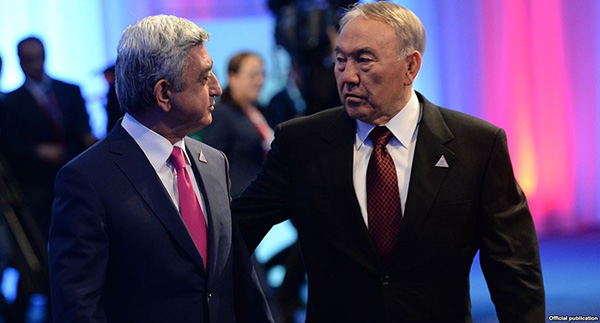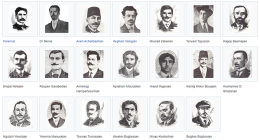On April 15, 2025, on the Occasion of AGBU’s 119th Anniversary, AGBU Armenia celebrated three decades of AGBU’s impactful activities in Armenia and Artsakh with a book presentation and wine daubing ceremony, celebrating the contemporary history of AGBU Armenia. The book, authored by Hovik Eordekian—former deputy director of AGBU Armenia and a longtime devoted member of the Union—explores the organization’s milestones.
The event featured speeches from Artoun Hamalian (USA), assistant to the AGBU president, and Zepure Tamerian from the Armenian Virtual College. To cap off the presentation, a short musical program was performed by Menua Melik-Haykazyan and Svetlana Hakobyan, winners of the “Discovering Talents with AGBU” competition.
The wine daubing ceremony was conducted by Reverend Father Asoghik Karapetyan, Vazgen Yacoubian, and the book’s author. The publication of the book was sponsored by the AGBU Levon Zaven Surmelian Foundation.
A Brief Review of the Book “AGBU in Armenia from 1991 to 2021”
It is important to note that beyond its significance as a detailed chronological documentation of the Union’s activities in Armenia over the past 30 years, the book is also notable by its parallel references to historical events, which the author consistently highlights throughout his records. The portrayal of activities, programs, and initiatives reflects the core vision of the Armenian General Benevolent Union’s mission, which is to ensure the intellectual and economic advancement of Armenians living in Armenia.
This comprehensive chronology, encapsulated in 359 pages, could be aptly titled “A Concise History of the Armenian General Benevolent Union.” It presents the Union’s activities in Armenia from 1991 to 2021 in chronological succession, while also providing an overview of the Union’s history preceding this period, beginning from its founding.
Easy to flip through, the reader-friendly text, and its broad contextual nature, make the book enjoyable and appealing for those seeking to understand the Union’s extensive activities and its clear, consistent mission in facing the profound impact of the political and regional complexities, crises, disasters, and often unpredictable developments, that shaped the last 120 years of our people’s history. At the same time, it is a handy guide and a primary source for historians.
This book summarizes the Armenian General Benevolent Union’s vast national activities across Western Armenia, Cilicia, Soviet Armenia, and later the Republic of Armenia, referencing relevant sources.
A quick glance at the content of the book reveals, like rapid succession of vivid cinematic frames, the founding vision—creating a global organization capable of addressing the hardships and needs of the Armenian people while fostering their intellectual and spiritual development. The organization’s rapid expansion, followed immediately by the Armenian Genocide, efforts of rescuing survivors, orphans, and refugees, aid and resettlement operations, repatriation programs, and educational initiatives all come to life within these pages.
Soviet Armenia, World War II, navigating complex and dangerous political relations, organizing and financing mass repatriation, securing healthcare, educational, cultural, and everyday life needs, developing strong ties between Soviet Armenia and the Diaspora, and fostering strong and unwavering bonds with the Mother See of Holy Etchmiadzin—all are chronicled here.
From the earthquake that shook Armenia to the awakening of the Diaspora and the coordination of relief efforts, to independence, the Karabakh movement, war, blockade, and the dark, cold years that followed—this book details the AGBU’s leading role in Armenia, its establishment of modern, forward-looking, and sustainable development structures, and its involvement in, among others, building the Saint Gregory the Illuminator Cathedral.
American University of Armenia, educational and development programs in Karabakh, the Union’s core pillars—cultural, educational, youth, humanitarian, and development—implemented with unwavering dedication.
The crisis of Syrian Armenians and the efforts to aid and organize support for those who sought refuge in Armenia. The establishment of the Union’s headquarters in Yerevan, alternative educational initiatives, Armenian Virtual College multilanguage distance learning programs and the Vahe Karapetian Center transferred to AGBU and its use for youth programs as well as relief efforts.
Collaboration with public organizations and international institutions, the centennial of the Armenian Genocide and the canonization of its martyrs, the Francophonie Summit, pan-Armenian assemblies, AGBU General Assemblies with accompanying initiatives, and Pan Armenian sports events.
Thirty years of independence—failures at strengthening Armenia’s statehood through building strong institutions and productive relations with the diaspora.
The Four-Day War, the Second Artsakh War, and Azerbaijan’s genocidal actions leading to the depopulation of Karabakh. The Union once again faces disasters and war, launching aid programs.
The notable years of leadership under Louise Manoogian-Simone and Berge Setrakian.
In other words, this book offers a clear and illuminating perspective on the Union’s steadfast and guiding presence in Armenia and throughout the diaspora. At the end of the volume, lists of programs, transfers, and partnerships, along with an index of names, and sources used are available.
Despite the existence of rich archival materials on AGBU’s history and activities, comprehensive historical analyses remain relatively few. In this regard, Edward Melkonian’s work “The History of the Armenian General Benevolent Union” holds particular significance.
Hovik Eordekian notes that the activities of the Union, particularly during the years of Soviet Armenia and the Republic of Armenia, have been comprehensively presented in the works of Vartkes Hamazasbian and Edward Melkonian, as well as in the jointly edited AGBU’s centenary two volume history by Haroutioun Raymond Gevorgyan and Vahe Tashjian. He also mentions that nearly two decades have passed since the publication of these works.
In light of these realities, Eordekian’s book, “A Glimpse into the Thirty-Year History of the AGBU, 1991-2021” stands out as a timely and significant contribution.
The author, Hovik Eordekian, approaches the subject with extensive knowledge, broad familiarity, and a deep understanding. Closely connected to the AGBU, he has actively participated in the organization’s evolution over many years in the Middle East, South America, and Armenia. Consequently, both as a diasporan Armenian and a citizen of Armenia, possessing a rich bibliographical background, and validating the research through personal relationships and close connections with individuals involved, his study extends beyond a chronological documentation of events, initiatives, and programs—it undoubtedly carries a much deeper essence.
Eordekian articulates this perspective clearly in the preface of his book, stating:
“Through traditional and modern innovative programs—such as visiting school groups, scout units, camps, artistic and professional experiences, distance learning, and professional networks—the AGBU continues to address the needs of Armenians dispersed across the Motherland and the diaspora, the Armenian General Benevolent Union strives to instill a deep sense of national identity and pride in the youth, fostering a profound interest in Armenian traditions and encouraging their commitment to preserving our rich heritage.
Since the independence of the Republic of Armenia, AGBU has implemented a wide array of humanitarian, educational, healthcare, cultural, social, and church building programs throughout the homeland. With special allocations supported by benefactors, these programs have encompassed all age groups and social sectors, improving the living conditions of hundreds of thousands and creating opportunities for employment.
It is my hope that this book serves as a preliminary step toward a broader historical analysis of AGBU’s global chapters. I am convinced that the Union’s extensive, century-old experience holds valuable lessons, which—through the unique local experiences of each chapter, their intra-community influences, and the diverse models of democratic operation, whether centralized or decentralized—can provide insightful guidance for the realities of the Armenian diaspora and the productive collaboration between the diaspora and the homeland.
ARTOUN HAMALIAN












